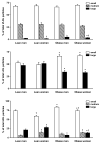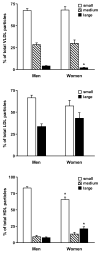Effect of obesity on the plasma lipoprotein subclass profile in normoglycemic and normolipidemic men and women
- PMID: 18779822
- PMCID: PMC2584161
- DOI: 10.1038/ijo.2008.164
Effect of obesity on the plasma lipoprotein subclass profile in normoglycemic and normolipidemic men and women
Abstract
Objective: To determine the effect of obesity without the confounding effect of metabolic complications on the lipoprotein subclass profile in men and women.
Design: Cross-sectional study.
Subjects: A total of 40 lean (body mass index (BMI): 18.5-25 kg/m(2)) and 40 obese (BMI: 30-45 kg/m(2)) subjects, with blood pressure <140/90 mm Hg, fasting plasma glucose concentration <100 mg per 100 ml and total triglyceride concentration <150 mg per 100 ml; all obese subjects had normal oral glucose tolerance.
Measurements: Fasting concentrations of very low-, intermediate-, low- and high-density lipoproteins (VLDL, IDL, LDL, and HDL, respectively) and average VLDL, LDL and HDL particle sizes were evaluated by using proton nuclear magnetic resonance spectroscopy.
Results: Obese compared with lean individuals of both sexes had increased plasma concentrations of VLDL (by approximately 50%), IDL (by approximately 100%), LDL (by approximately 50%), and to some extent HDL (by approximately 10%) particles (P<0.05). The contribution of large VLDL to total VLDL concentration, small LDL to total LDL concentration, and small HDL to total HDL concentration was greater in obese than lean subjects (P<0.05), resulting in larger average VLDL size but smaller average LDL and HDL sizes (P<0.05). Women, compared with men, had reduced concentrations of total VLDL particles (by approximately 10%) due to lower concentrations of large and medium VLDL and a shift toward large at the expense of small HDL particles (P<0.05), with no difference in total HDL particle concentration. IDL and total LDL concentrations and LDL subclass distribution were not different between men and women.
Conclusion: Obesity is associated with pro-atherogenic alterations in the lipoprotein subclass profile, which may increase cardiovascular disease risk even in the absence of classical metabolic risk factors. On the other hand, the female cardiovascular disease risk advantage is probably largely related to differences in traditional lipid risk factors (plasma triglyceride and HDL-cholesterol concentrations) because sex differences in the plasma lipoprotein subclass profile are minimal.
Figures


Similar articles
-
Effects of insulin resistance and type 2 diabetes on lipoprotein subclass particle size and concentration determined by nuclear magnetic resonance.Diabetes. 2003 Feb;52(2):453-62. doi: 10.2337/diabetes.52.2.453. Diabetes. 2003. PMID: 12540621
-
Adiponectin is associated with favorable lipoprotein profile, independent of BMI and insulin resistance, in adolescents.J Clin Endocrinol Metab. 2011 May;96(5):1549-54. doi: 10.1210/jc.2010-2364. Epub 2011 Mar 2. J Clin Endocrinol Metab. 2011. PMID: 21367935 Free PMC article.
-
Lipoprotein subclasses and particle sizes and their relationship with coronary artery calcification in men and women with and without type 1 diabetes.Diabetes. 2002 Jun;51(6):1949-56. doi: 10.2337/diabetes.51.6.1949. Diabetes. 2002. PMID: 12031985
-
Impact of insulin resistance on lipoprotein subpopulation distribution in lean and morbidly obese nondiabetic women.Metabolism. 2000 Mar;49(3):285-92. doi: 10.1016/s0026-0495(00)80002-5. Metabolism. 2000. PMID: 10726902
-
Serum cholesterol and triglyceride reference ranges of twenty lipoprotein subclasses for healthy Japanese men and women.Atherosclerosis. 2013 Dec;231(2):238-45. doi: 10.1016/j.atherosclerosis.2013.09.008. Epub 2013 Oct 1. Atherosclerosis. 2013. PMID: 24267234
Cited by
-
The effect of insulin resistance and obesity on low-density lipoprotein particle size in children.J Clin Res Pediatr Endocrinol. 2010;2(2):63-6. doi: 10.4274/jcrpe.v2i2.63. Epub 2010 May 2. J Clin Res Pediatr Endocrinol. 2010. PMID: 21274340 Free PMC article.
-
Body mass index impacts the choice of lipid-lowering treatment with no correlation to blood cholesterol - Findings from 52 916 patients in the Dyslipidemia International Study (DYSIS).Diabetes Obes Metab. 2018 Nov;20(11):2670-2674. doi: 10.1111/dom.13415. Epub 2018 Jul 10. Diabetes Obes Metab. 2018. PMID: 29888459 Free PMC article.
-
Association of obesity and LDL subfractions evaluated by body mass index, waist circumference, and diabetes status: the ELSA-Brasil study.Diabetol Metab Syndr. 2025 Mar 6;17(1):83. doi: 10.1186/s13098-025-01644-5. Diabetol Metab Syndr. 2025. PMID: 40050922 Free PMC article.
-
Prevalence of plasma small dense LDL is increased in obesity in a Thai population.Lipids Health Dis. 2015 Apr 18;14:30. doi: 10.1186/s12944-015-0034-1. Lipids Health Dis. 2015. PMID: 25925050 Free PMC article.
-
Association between Vitamin D Deficiency and High Serum Levels of Small Dense LDL in Middle-Aged Adults.Biomedicines. 2021 Apr 24;9(5):464. doi: 10.3390/biomedicines9050464. Biomedicines. 2021. PMID: 33923190 Free PMC article.
References
-
- National Cholesterol Education Program. Third Report of the National Cholesterol Education Program (NCEP) Expert Panel on Detection, Evaluation, and Treatment of High Blood Cholesterol in Adults (Adult Treatment Panel III) Final Report. Circulation. 2002;106:3143–3421. - PubMed
-
- Kochanek KD, Murphy SL, Anderson RN, Scott C. Deaths: final data for 2002. Natl Vital Stat Rep. 2004;53:1–115. - PubMed
-
- Carmena R, Duriez P, Fruchart JC. Atherogenic lipoprotein particles in atherosclerosis. Circulation. 2004;109:III2–7. - PubMed
-
- Freedman DS, Otvos JD, Jeyarajah EJ, Barboriak JJ, Anderson AJ, Walker JA. Relation of lipoprotein subclasses as measured by proton nuclear magnetic resonance spectroscopy to coronary artery disease. Arterioscler Thromb Vasc Biol. 1998;18:1046–1053. - PubMed
-
- Hodis HN, Mack WJ, Dunn M, Liu C, Selzer RH, Krauss RM. Intermediate-density lipoproteins and progression of carotid arterial wall intima-media thickness. Circulation. 1997;95:2022–2026. - PubMed
Publication types
MeSH terms
Substances
Grants and funding
LinkOut - more resources
Full Text Sources
Medical

